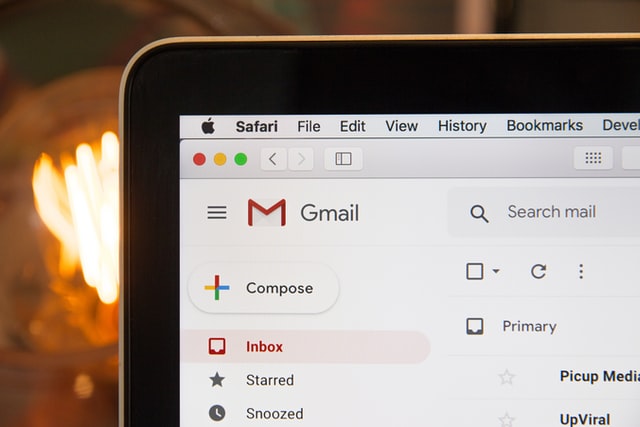Do you know the difference between a marketing email and a new business email? Or when you should use one versus the other? If you aren’t certain, you’re not the only one!
Marketing emails and new business outreach emails both serve key purposes, but they are very different animals. It’s important to have a realistic understanding of what each type of email does best. In this post, we’ll cover the key differences and explain why even brilliantly-crafted marketing emails are unlikely to generate new business for your agency.

Marketing emails and new business-generation emails
In the 12 years that The Duval Partnership has been in business, we’ve written and deployed countless lead-generation emails on behalf of our agency partners. These are outbound new business messages to highly targeted but (often) cold prospect lists.
Sometimes we encounter agencies who’ve been using marketing emails under the umbrella of their new business program or who believe highly designed, HTML-heavy emails are the best way to represent their agency to prospective clients. This comes from a misunderstanding of the differences between marketing and new business emails and how to use each type effectively.
First, let’s confirm what we mean when we talk about “agency marketing emails” and “agency new business emails.” This table reflects some generalizations about these types of emails and assumes both types are properly executed.
|
Agency Marketing Emails |
Agency New Business Emails |
|
Inbound marketing |
Outbound marketing |
|
Sent to warm, subscriber-based lists |
Sent to cold lists |
|
Contact initiated |
Agency initiated |
|
Sent to a wide range of contacts, many of whom are unqualified |
Sent to highly targeted and qualified decision-makers |
|
Message tone is one-to-many |
Message tone is one-to-one |
|
Typically highly-designed and “pretty,” with graphics and lots of links (and HTML code) |
Typically plain, little formatting, little to no HTML, may include 1-3 links and a logo graphic, mimic the look of plain text emails |
|
Purpose: to educate, inform, engage, nurture, build the brand, build trust, extend the relationship |
Purpose: to educate and build awareness, to make a connection, to have a conversation or meeting, to generate leads |
|
Typical CTA: to view or download content via a stylized, colored graphic button |
Typical CTA: in-text request to respond or request for a conversation |
|
Includes dynamic personalization fields |
Uses both dynamic personalization fields and manual customization |
|
Usually part of a marketing strategy that only includes emails |
Usually part of an outreach strategy that alternates between emails and calls for a minimum of 6-8 total touches |
|
Organizational - may come from a person but is generally viewed as representing “the organization” |
Individual - viewed as coming from an individual working on behalf of an organization |
|
May continue indefinitely |
Will continue for a fixed period or number of “touches” |
|
From a marketing funnel perspective, marketing emails start earlier on and take much longer to (possibly) become qualified and passed to sales |
From a marketing funnel perspective, sales emails start further down the funnel and have a shorter path to conversation and close |
|
May have multiple messages within a single email and be either short or long |
Will have a concise, direct, targeted message |
|
Typically links to educational, informational content (often gated) |
Links typically point to work and case studies but may sometimes link to relevant news items or high-level, ungated content |
|
Talks about things that may be helpful, or of interest |
Talks about solving the prospect’s business challenges |
|
May or may not incorporate social proof points and engagement metrics |
Leans on business-oriented proof points: KPIs, results |
|
Offers engagement analytics via small pixel graphics and link tracking |
Typically offers engagement analytics via small pixel graphics and link tracking |
Marketing emails are usually considered more desirable and effective in certain contexts (for example, B2C, D2C, eCommerce, brand-building, and driving engagement). However, plain text and “plain text-like” emails are more desirable and effective in others (for example, B2B, lead generation, and sales).
It’s important to understand why marketing emails are poorly suited for new business purposes. Below, we outline four of the most important reasons.
1. Expectations
Marketing emails are the dominant type of email; I get hundreds of them every day. They are supposed to be opt-in emails—but sometimes they aren’t. There is a lot of garbage and a lot of repetition.
Here’s what these beautifully-crafted marketing emails don’t do: they don’t send a signal that business needs to take place. In terms of consumer-focused messages, marketing emails might do a great job of promoting sales and inspiring engagement. Still, they aren’t a vehicle for doing serious business and closing sizable deals.
Cold outreach emails have a bit of a PR problem. SPAM emails (often associated with purchased, non-opt-in lists to cold targets) are largely responsible for the inbound marketing revolution. But the ongoing “batch and blast” tactics of marketing emails can feel spammier than cold lead gen emails, even after opting in.
In B2B, cold outreach is still how a lot of opportunities are generated. It's a proven tactic used by respected organizations. Some cold emails might create inbox garbage for some prospects, but for others, they are valuable. The difference in the new business outreach messages we send is that they are personal, highly targeted, highly relevant, prospect-oriented, and concise. We seek mutually-beneficial partnerships, and we don’t want to waste anyone’s time, including our own.
Most importantly, new business emails send a signal (visually and in the message content) that it is one-to-one and business-oriented. The perception is that it comes from an individual and not a giant list in a marketing machine. The expected conversation could result in material benefit to the business. Think about the types of emails you receive and how their delivery and format affect your perception of them.
“...cold emails should never have lots of colors, bold, HTML formatting, bullets, numbered lists, or anything else that might resemble a mass marketing email. Likewise, the more you can signal to your recipient that this message was crafted especially for them, the better your odds are.” — Heather R. Morgan, CEO of SalesFolk, via Inc.
2. Targeting
Marketing emails are meant to be sent in bulk, whether it’s to a targeted list segment at one point in time, an automatically triggered email, or part of an ongoing workflow that sends people through on a rolling basis.
There might be some targeting applied to the marketing email (such as by location, title/role, content downloaded, or some other identifier), but at many organizations, the distinctions between messages are superficial, automated, and the message is still relatively canned. Based on the email’s function, it doesn’t usually make sense to dig deeper for more advanced targeting.

Often, there might be only vague goals for a recipient with a particular email, such as continuing through to the next step of the marketing funnel or simply engaging on the email. Well-planned marketing workflows might try to progressively build out information about the prospect through different forms used in gated content pushed in the emails. Ultimately, they may hand off a marketing-qualified prospect to the sales/new business team, but those leads can be of variable quality.
On the other hand, our goal with every new business outreach email is very specific and consistent. We want to engage in communication—whether that is an email response, a phone conversation, or a meeting. The stakes are higher for new business emails, as is the potential upside. For that reason, new business emails must be more targeted, more direct, and more relevant than a marketing email to be effective.
We know that even if a prospect opens our email, they will likely only look at it for a second before determining whether it’s worth their attention. There can’t be any fluff, and it must be highly focused on solving prospects’ problems with clear proof points.
New business emails are meant to have the appearance of personal, one-to-one emails, which applies to the message as well as the design. In our process, we start with curated prospect lists that are refined with multiple targeting criteria and manual reviews. We apply selling points, proof points, challenges, and solutions specific to that small group and create email templates to provide a starting point for one-to-one emails. We then incorporate personalization tokens and manually personalized elements before deploying each one individually to maintain the feel of a one-to-one email.
“I would much rather see reps take their time on those emails rather than being super automated, even if that means they send out 50 emails a day instead of 300. They’ll get twice as many people to respond from those personalized messages.” — Beth Abbott, Inside Sales Manager at New Breed (on sending smaller quantities of highly-customized sales emails based on templates)
3. Deliverability
Because marketing emails are typically deployed to opt-in lists, they are more likely to be delivered without landing in the junk folder (even if they still end up in the promotional email tab). New business outreach emails enjoy none of that security because they are usually sent “cold.”
It can be a real challenge to get through to the prospect’s inbox. Email platform Validity found that 1 in 6 emails failed to reach the inbox in 2019, on average. For that reason, we must apply stricter HTML and graphic limits to new business outreach emails than we might for marketing emails—or even to a one-to-one email sent to a known connection.
Why focus on limiting HTML and images? Hubspot did a series of A/B tests that found the more HTML and graphics in an email, the more deliverability suffered (at about 25% fewer opens per send). Hubspot also found that more images translated to fewer clicks (or conversions). They hypothesized that the lower open rates for HTML-based emails were due to deliverability issues. According to Hubspot, more HTML elements and images will cause email clients’ filtering systems to flag the email as SPAM or promotional.
Hubspot is not the only one to identify deliverability issues as a result of HTML elements and images. Marc Wayshak of Sales Insights Lab gave a presentation on sales emails last year, sponsored by Clearslide. He says that his organization had “tested, sent and tracked over one million emails” last year. He's found that to ensure email deliverability, it is sometimes necessary to omit all links and graphic files in the email (including the agency logo and email signature links). Even bolded text and formatting features like bullets require some HTML, so to combat very aggressive email client filters, you may need to omit them.
In our experience, it's usually okay to include one or two links, and we typically start with an email that may include a line of bolded text and an agency logo graphic. However, if we encounter deliverability and engagement issues, we will change strategies to get more aggressive about omitting graphics, links, and HTML. Ultimately, we want the email to be read, and it can’t be read if it isn’t deliverable. This is something you should monitor and test for yourself.
Needless to say, sending a traditional marketing format email to a cold new business prospect would be the worst of both worlds in terms of deliverability and effectiveness.
4. Brand Representation
The agency brand doesn't get enough attention when agencies consider email strategies. Marketing emails are a creative product, and they fall within the services many agencies provide. While the agency category is diverse, there is generally an expectation from agency prospects that agencies will demonstrate competence, if not excellence, in their email strategy and messages.

Prospects might reasonably expect that marketing emails will be crafted with care and subject to several layers of testing before they go out. Carelessness might be interpreted as a reflection of the agency’s work product more broadly.
Agencies set themselves up to be judged by the marketing emails they send, and when they fall short, it reflects on their capabilities and brand. That includes sending non-targeted messages, HTML messages that don’t render well and sending subscription-based emails to people who have not opted in.
On the other hand, one-to-one emails should be polished but usually come with lower expectations and the understanding that they represent one person's communication vs. "a marketing effort" of the agency.
Will anyone ever look at a one-off email from your agency’s new business director, see a typo, and then think, “Do I really want this agency doing my email marketing for me?” Probably not. But when they see typos in a marketing email, they might.
Parting thoughts
New business outreach is an important way to proactively target the clients your agency wants (and has a right) to win while broadening your agency’s reach and building out your sales funnel. Waiting for leads to come to you (via your website or via referral) can lead to inconsistencies in the agency pipeline and client quality.
Once you’ve decided to incorporate new business outreach emails, make sure you are using the correct format and tactics to accomplish your goals. Don’t send out marketing emails thinking that they will generate new business. If your goal is to secure agency new business, use a strategy-backed sequence of new business emails and cold calls to reach a targeted list.
Why incorporate phone calls and voicemails into your new business outreach? Using two methods of contact can increase the contact rate by 161% (and by another 55% when a third method is incorporated) (Xant, 2017).
Have more questions about new business emails and outreach strategies? Let us know in the comments.
Are you subscribed yet?
Read more:
- How to Reach Your New Business Prospects via Email in 2021
- 4 Ways Agencies Mess Up New Business Outreach & How To Fix It
- How To Use Personalization In Emails For Agency New Business
- Tips and Insights for Better Agency New Business Emails
- How Can the B2B Buyer Experience Help Grow Your Agency?
- Email Lead Nurturing for Agency New Business
- Why Agencies Can’t Count on Blogging Their Way to New Business
Image credits: Photo by Headway on Unsplash; Photo by Stephen Phillips - Hostreviews.co.uk on Unsplash; Photo by Brooke Cagle on Unsplash



